lcd1602液晶封装函数
LCD1602
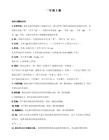
PORT_A=0xff;
rs=0;
rw=1;
en=1;
PORT=0x00; //把8155A口由输出状态转为输入状态
while(PORT_A & 0x80);
PORT=0x03; //把8155A口由输入状态转为输出状态
}
void wri(uchar dat)//写指令
**********************************************************/
#include <INIF.h>
uchar qq;
bit flag=0;
/********************************************************
}
//LCD1602的初始化函数
void lcd1602init( )
{
wri(0x01);/*清除显示*/
wri(0x38);/*设置8位格式,2行,5*7*/
wri(0x06);/*设定输入方式,增量不移位*/
wri(0x0c);/*整体显示,关光标,不闪烁*/
}
//LCD1602的清屏函数
void lcd_clear()
{
wri( 0x01 );
}
/****************************************d lcd_string( uchar *p, uchar flag )
* 参数说明:无参数 *
* 3.函数名称:void lcd_string( uchar *p, uchar flag ) *
* 函数功能:1602LCD显示函数 *
LCD1602库函数
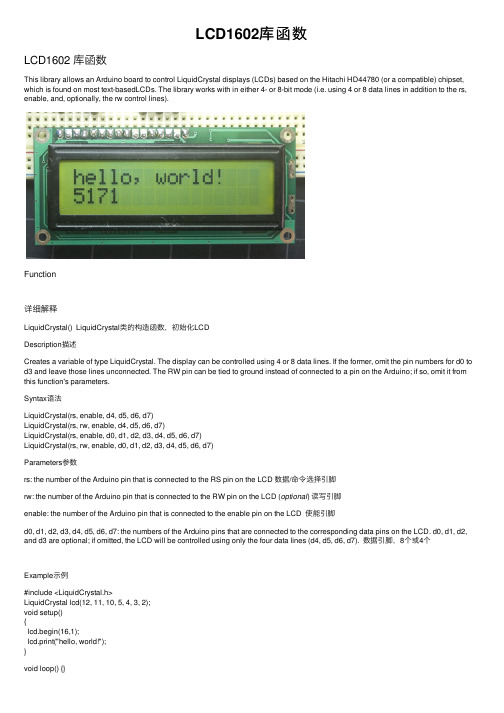
LCD1602库函数LCD1602 库函数This library allows an Arduino board to control LiquidCrystal displays (LCDs) based on the Hitachi HD44780 (or a compatible) chipset, which is found on most text-basedLCDs. The library works with in either 4- or 8-bit mode (i.e. using 4 or 8 data lines in addition to the rs, enable, and, optionally, the rw control lines).Function详细解释LiquidCrystal() LiquidCrystal类的构造函数,初始化LCDDescription描述Creates a variable of type LiquidCrystal. The display can be controlled using 4 or 8 data lines. If the former, omit the pin numbers for d0 to d3 and leave those lines unconnected. The RW pin can be tied to ground instead of connected to a pin on the Arduino; if so, omit it from this function's parameters.Syntax语法LiquidCrystal(rs, enable, d4, d5, d6, d7)LiquidCrystal(rs, rw, enable, d4, d5, d6, d7)LiquidCrystal(rs, enable, d0, d1, d2, d3, d4, d5, d6, d7)LiquidCrystal(rs, rw, enable, d0, d1, d2, d3, d4, d5, d6, d7)Parameters参数rs: the number of the Arduino pin that is connected to the RS pin on the LCD 数据/命令选择引脚rw: the number of the Arduino pin that is connected to the RW pin on the LCD (optional) 读写引脚enable: the number of the Arduino pin that is connected to the enable pin on the LCD 使能引脚d0, d1, d2, d3, d4, d5, d6, d7: the numbers of the Arduino pins that are connected to the corresponding data pins on the LCD. d0, d1, d2, and d3 are optional; if omitted, the LCD will be controlled using only the four data lines (d4, d5, d6, d7). 数据引脚,8个或4个Example⽰例#include <LiquidCrystal.h>LiquidCrystal lcd(12, 11, 10, 5, 4, 3, 2);void setup(){lcd.begin(16,1);lcd.print("hello, world!");}begin() 初始化LCD的界⾯,设置LCD尺⼨DescriptionInitializes the interface to the LCD screen, and specifies the dimensions (width and height) of the display. begin()needs to be called before any other LCD library commands.Syntaxlcd.begin(cols, rows)Parameterslcd: a variable of type LiquidCrystalcols: the number of columns that the display has 列数rows: the number of rows that the display has ⾏数clear() 清屏,光标在左上⾓DescriptionClears the LCD screen and positions the cursor in the upper-left corner.Syntaxlcd.clear()Parameterslcd: a variable of type LiquidCrystalhome() 光标复位,定位于左上⾓DescriptionPositions the cursor in the upper-left of the LCD. That is, use that location in outputting subsequent text to the display. To also clear the display, use the function instead.Syntaxlcd.home()Parameterslcd: a variable of type LiquidCrystalsetCursor() 设置光标位置DescriptionPosition the LCD cursor; that is, set the location at which subsequent text written to the LCD will be displayed.Syntaxlcd.setCursor(col, row)Parameterslcd: a variable of type LiquidCrystalcol: the column at which to position the cursor (with 0 being the first column)row: the row at which to position the cursor (with 0 being the first row)write() 写⼀个字符到LCDWrite a character to the LCD.Syntaxlcd.write(data)Parameterslcd: a variable of type LiquidCrystaldata: the character to write to the displayReturnsbytewrite() will return the number of bytes written, though reading that number is optionalExample#include <LiquidCrystal.h>LiquidCrystal lcd(12, 11, 10, 5, 4, 3, 2);void setup(){Serial.begin(9600);}void loop(){if (Serial.available()){lcd.write(Serial.read());}}print() ⽂本输出到LCDDescriptionPrints text to the LCD.Syntaxlcd.print(data)lcd.print(data, BASE) 输出格式可以是⼆进制,⼗进制,⼋进制,⼗六进制Parameterslcd: a variable of type LiquidCrystaldata: the data to print (char, byte, int, long, or string)BASE (optional): the base in which to print numbers: BIN for binary (base 2), DEC for decimal (base 10), OCT for octal (base 8), HEX for hexadecimal (base 16).Returnsbyteprint() will return the number of bytes written, though reading that number is optionalExample#include <LiquidCrystal.h>LiquidCrystal lcd(12, 11, 10, 5, 4, 3, 2);void setup(){cursor() 显⽰光标DescriptionDisplay the LCD cursor: an underscore (line) at the position to which the next character will be written.Syntaxlcd.cursor()Parameterslcd: a variable of type LiquidCrystalnoCursor() 隐藏光标DescriptionHides the LCD cursor.Syntaxlcd.noCursor()Parameterslcd: a variable of type LiquidCrystalblink() 光标闪烁DescriptionDisplay the blinking LCD cursor. If used in combination with the () function, the result will depend on the particular display. Syntaxlcd.blink()Parameterslcd: a variable of type LiquidCrystalnoBlink() 光标不闪烁DescriptionTurns off the blinking LCD cursor.Syntaxlcd.noBlink()Parameterslcd: a variable of type LiquidCrystaldisplay() 开启LCD显⽰功能,DescriptionParameterslcd: a variable of type LiquidCrystalnoDisplay() 关闭LCD显⽰功能,但之前的显⽰内容不丢失DescriptionTurns off the LCD display, without losing the text currently shown on it.Syntaxlcd.noDisplay()Parameterslcd: a variable of type LiquidCrystalscrollDisplayLeft() 向左滚屏,LCD显⽰的内容往左移⼀格DescriptionScrolls the contents of the display (text and cursor) one space to the left.Syntaxlcd.scrollDisplayLeft()Parameterslcd: a variable of type LiquidCrystalscrollDisplayRight() 向右滚屏,显⽰的内容往右移⼀格DescriptionScrolls the contents of the display (text and cursor) one space to the right.Syntaxlcd.scrollDisplayRight()Parameterslcd: a variable of type LiquidCrystalautoscroll() ⾃动滚屏,输⼊时光标在⼀个固定位置,字符⾃动移动DescriptionTurns on automatic scrolling of the LCD. This causes each character output to the display to push previous characters over by one space. If the current text direction is left-to-right (the default), the display scrolls to the left; if the current direction is right-to-left, the display scrolls to the right. This has the effect of outputting each new character to the same location on the LCD.Syntaxlcd.autoscroll()Parameterslcd: a variable of type LiquidCrystalTurns off automatic scrolling of the LCD.Syntaxlcd.noAutoscroll()Parameterslcd: a variable of type LiquidCrystalleftToRight() ⽂本显⽰时的移动⽅向是从左往右,默认⽅向DescriptionSet the direction for text written to the LCD to left-to-right, the default. This means that subsequent characters written to the display will go from left to right, but does not affect previously-output text.Syntaxlcd.leftToRight()Parameterslcd: a variable of type LiquidCrystalrightToLeft() ⽂本显⽰时的移动⽅向是从右往左DescriptionSet the direction for text written to the LCD to right-to-left (the default is left-to-right). This means that subsequent characters written to the display will go from right to left, but does not affect previously-output text.Syntaxlcd.rightToLeft()Parameterslcd: a variable of type LiquidCrystalcreateChar() 建⽴⼀个⾃定义的图形字符DescriptionCreate a custom character (glyph) for use on the LCD. Up to eight characters of 5x8 pixels are supported (numbered 0 to 7). The appearance of each custom character is specified by an array of eight bytes, one for each row. The five least significant bits of each byte determine the pixels in that row. To display a custom character on the screen, () its number.NB : When referencing custom character "0", if it is not in a variable, you need to cast it as a byte, otherwise the compiler throws an error. See the example below.Syntaxlcd.createChar(num, data)Parameterslcd: a variable of type LiquidCrystalnum: which character to create (0 to 7)data: the character's pixel dataLiquidCrystal lcd(12, 11, 5, 4, 3, 2); byte smiley[8] = //微笑图案{B11011,B00000,B01010,B00000,B00000,B10001,B10001,B01110,};void setup(){lcd.createChar(0, smiley);lcd.begin(16, 2);lcd.write(byte(0));}void loop() {}。
15LCD1602液晶的基本驱动函数
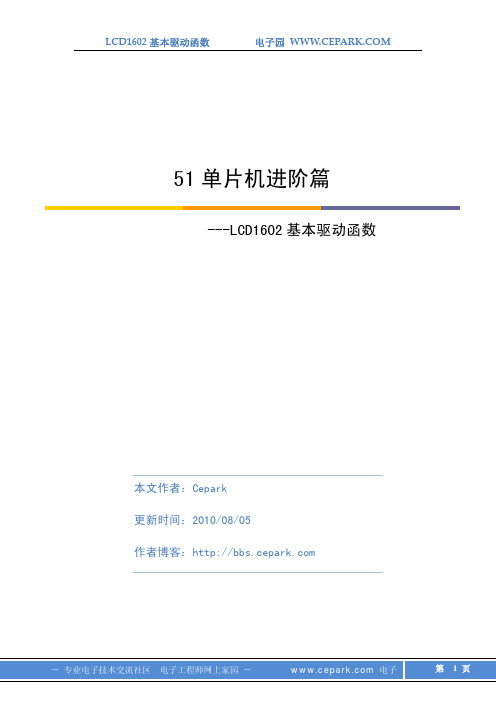
51单片机进阶篇---LCD1602基本驱动函数本文作者:Cepark更新时间:2010/08/05作者博客:在本次课中我们将介绍LCD1602液晶的使用。
LCD:英文全称为Liquid Crystal Display,即为液态晶体显示,也就是我们常说的液晶显示了。
1602则是表示这个液晶一共能显示2行数据,每一行显示16个字符(英文字符,不是汉字)。
这个就是LCD1602的全部来由。
液晶显示的使用广泛,现在LCD的价格已经很便宜了,被广泛的应用的各种显示场合。
下面是LCD1602的实物图。
接下来进入LCD1602使用的重点:操作时序。
操作时序永远使用是任何一片IC芯片的最主要的内容。
一个芯片的所有使用细节都会在它的官方器件手册上包含。
所以使用一个器件事情,要充分做好的第一件事就是要把它的器件手册上有用的内容提取,掌握。
介于中国目前的芯片设计能力有限,所以大部分的器件都是主要外国几个IC巨头比如TI、AT、MAXIM这些公司生产的,器件资料自然也是英文的多,所以,英文的基础要在阅读这些数据手册时得到提高哦。
即便有中文翻译版本,还是建议看英文原版,看不懂时不妨再参考中文版,这样比较利于提高。
我们首先来看1602的引脚定义,1602的引脚是很整齐的SIP单列直插封装,所以器件手册只给出了引脚的功能数据表:我们只需要关注以下几个管脚:3脚:VL,液晶显示偏压信号,用于调整LCD1602的显示对比度,一般会外接电位器用以调整偏压信号,注意此脚电压为0时可以得到最强的对比度。
4脚:RS,数据/命令选择端,当此脚为高电平时,可以对1602进行数据字节的传输操作,而为电平时,则是进行命令字节的传输操作。
命令字节,即是用来对LCD1602的一些工作方式作设置的字节;数据字节,即使用以在1602上显示的字节。
值得一提的是,LCD1602的数据是8位的。
5脚:R/W,读写选择端。
当此脚为高电平可对LCD1602进行读数据操作,反之进行写数据操作。
lcd1602液晶显示函数流程设计
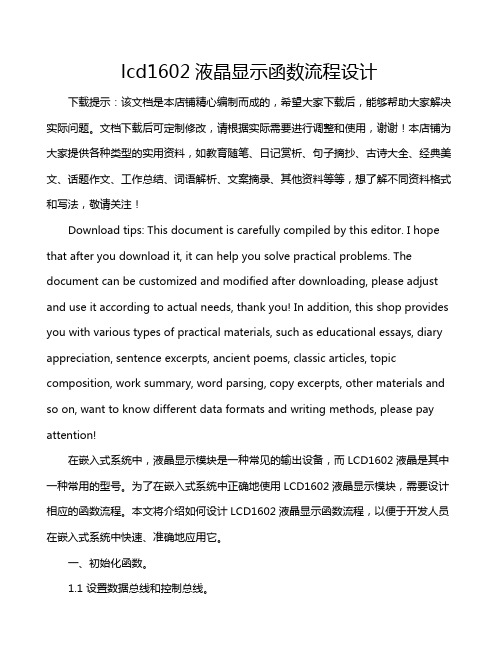
lcd1602液晶显示函数流程设计下载提示:该文档是本店铺精心编制而成的,希望大家下载后,能够帮助大家解决实际问题。
文档下载后可定制修改,请根据实际需要进行调整和使用,谢谢!本店铺为大家提供各种类型的实用资料,如教育随笔、日记赏析、句子摘抄、古诗大全、经典美文、话题作文、工作总结、词语解析、文案摘录、其他资料等等,想了解不同资料格式和写法,敬请关注!Download tips: This document is carefully compiled by this editor. I hope that after you download it, it can help you solve practical problems. The document can be customized and modified after downloading, please adjust and use it according to actual needs, thank you! In addition, this shop provides you with various types of practical materials, such as educational essays, diary appreciation, sentence excerpts, ancient poems, classic articles, topic composition, work summary, word parsing, copy excerpts, other materials and so on, want to know different data formats and writing methods, please pay attention!在嵌入式系统中,液晶显示模块是一种常见的输出设备,而LCD1602液晶是其中一种常用的型号。
LCD1602液晶显示完全资料
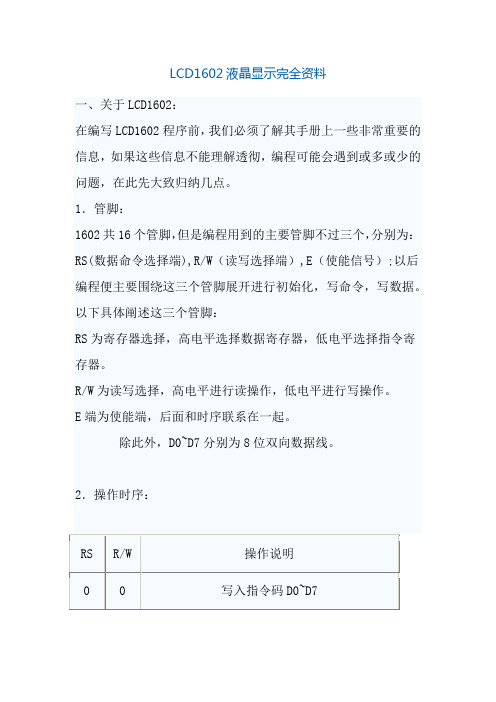
LCD1602液晶显示完全资料0x18 光标和显示一起向左移动4.显示地址:LCD1602内部RAM显示缓冲区地址的映射图,00~0F、40~4F分别对应LCD1602的上下两行的每一个字符,只要往对应的RAM地址写入要显示字符的ASCII代码,就可以显示出来。
5.读写时序:时序图1602手册中有,这里不引用了。
时序图很重要,编程就是根据时序图设置寄存器,让LCD工作。
二、LCD1602程序编写流程:LCD1602在了解完以上信息后便可以编写,这里我们把程序分为以下几步:1.定义LCD1602管脚,包括RS,R/W,E。
这里定义是指这些管脚分别接在单片机哪些I/O口上。
现举例如下:sbit EN=P3^4;sbit RS=P3^5;sbit RW=P3^6;2.显示初始化,在这一步进行初始化及设置显示模式等操作,包括以下步骤:设置显示方式延时清理显示缓存设置显示模式通常推荐的初始化过程如下:延时15ms写指令38H延时5ms写指令38H延时5ms写指令38H延时5ms注:以上写38H指令可以看情况省略1~2步(以上都不检测忙信号)(以下都要检测忙信号)写指令38H写指令08H 关闭显示写指令01H 显示清屏写指令06H 光标移动设置写指令0cH 显示开及光标设置3.设置显示地址(写显示字符的位置)。
4.写显示字符的数据。
三、LCD1602各子程序模块及主程序编写:现在按照上面编写程序的流程,给出各子程序模块及主程序的例子。
1.头文件,宏定义,定义管脚等:#include<reg52.h>#include <string.h>#define uchar unsigned char#define uint unsigned intsbit EN=P3^4;sbit RS=P3^5;sbit RW=P3^6;uchar code table0[]={"QQ:545699636"}; //此条语句为显示字符串时定义的字符串数组2.LCD1602基本初始化子程序:void LCD1602(){EN=0;RS=1;RW=1;P0=0xff; //这里P0为与LCD D0~D7相连的I/O口}3.读忙子程序:void read_busy(){P0=0xff;RS=0;RW=1;EN=1;while(P0&0x80); //P0和10000000相与,D7位若不为0,停在此处EN=0; //若为0跳出进入下一步;这条语句的作用就是检测D7位} //若忙在此等待,不忙跳出读忙子程序执行读写指令4.写指令写数据子程序:void write(uchar i,bit j){read_busy();P0=i; //其中i=0,写指令;i=1,写数据;RS=j;RW=0;EN=1;EN=0;}5.延时子程序:void delay(uint c) //功能为提供初始化等其他子程序中的延时1xc MS{uint a,b;for(a=0;a<c;a++)for(b=0;b<120;b++);}6.LCD1602初始化子程序:void init() //完全按照要求初始化流程来,中间省略了一步写指令38H{delay(15);write(0x38,0);delay(5);write(0x38,0);write(0x08,0);write(0x01,0);write(0x06,0);write(0x0c,0);}7.显示单个字符子程序:void display_lcd_byte(uchar y,uchar x,uchar z) //Y=0,1(起始行)X=0~15(起始列)Z=想写字符的ASCII码{if(y) //是否显示在第二行(若在第一行Y=0,不进入IF语句,若在第二行,进入IF语句{x+=0x40; //第二行起始地址加上列数为字符显示地址}x+=0x80; //设置数据指针位置write(x,0);write(z,1); //写入数据}8.显示字符串子程序:void display_lcd_text(uchar y,uchar x,uchartable[]) //Y,X同上字符显示,table[]字符串数组{uchar z=0;uchar t;t=strlen(table)+x; // 求得字符串长度加上起始列位置 while(x<t) //功能为LCD显示到字符串最后一个字符,防止字符串{ //没有16个字符,从而不够位产生乱码; display_lcd_byte(y,x,table[z]); //逐位显示数组内字符x++;z++;}}9.主程序:主程序里除了放入初始化程序外就是加入自己编写的显示子程序,根据你所要的不用功能可以编写各种类型的显示子程序,这里不做详细介绍,以下举例为显示一个字符和显示字符串的显示子程序。
LCD1602函数集
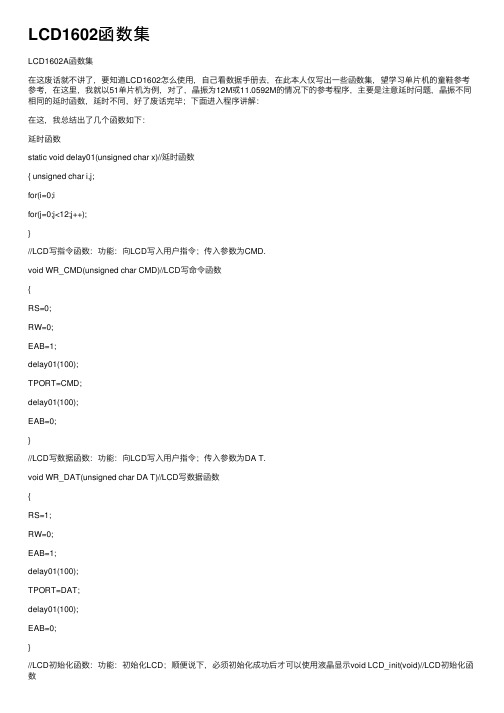
LCD1602函数集LCD1602A函数集在这废话就不讲了,要知道LCD1602怎么使⽤,⾃⼰看数据⼿册去,在此本⼈仅写出⼀些函数集,望学习单⽚机的童鞋参考参考,在这⾥,我就以51单⽚机为例,对了,晶振为12M或11.0592M的情况下的参考程序,主要是注意延时问题,晶振不同相同的延时函数,延时不同,好了废话完毕;下⾯进⼊程序讲解:在这,我总结出了⼏个函数如下:延时函数static void delay01(unsigned char x)//延时函数{ unsigned char i,j;for(i=0;ifor(j=0;j<12;j++);}//LCD写指令函数:功能:向LCD写⼊⽤户指令;传⼊参数为CMD.void WR_CMD(unsigned char CMD)//LCD写命令函数{RS=0;RW=0;EAB=1;delay01(100);TPORT=CMD;delay01(100);EAB=0;}//LCD写数据函数:功能:向LCD写⼊⽤户指令;传⼊参数为DA T.void WR_DAT(unsigned char DA T)//LCD写数据函数{RS=1;RW=0;EAB=1;delay01(100);TPORT=DAT;delay01(100);EAB=0;}//LCD初始化函数:功能:初始化LCD;顺便说下,必须初始化成功后才可以使⽤液晶显⽰void LCD_init(void)//LCD初始化函数{WR_CMD(0x30);WR_CMD(0X30);WR_CMD(0x30);WR_CMD(0x38);WR_CMD(0x08);WR_CMD(0x01);WR_CMD(0x06);WR_CMD(0x0e);}//LCD在指定的位置写数据函数:功能:吧想要显⽰的数据输出到显⽰屏void WR_DATA(unsigned char line,unsigned char location,unsigned char DA TA)//LCD定位写数据函数{ static unsigned char i;delay01(100);if(line==0){ i=0x80+location;WR_CMD(i);}else{ i=0x80+0x40+location;WR_CMD(i);}delay01(100);WR_DAT(DA TA);i=0;}//指定在第⼏⾏第⼏列开始写数据:功能:指定从第⼏⾏第⼏列开始写数据void WR_str(unsigned char linex,unsigned char locationy,unsigned char *stri)//LCD定位写字符{ static unsigned char i; delay01(100);if(linex==0){ i=0x80+locationy;}else{ i=0x80+0x40+locationy;}delay01(100);while(*stri){WR_CMD(i);WR_DAT(*stri);i++;stri++;}i=0;}//创建⾃定义字符函数:功能:把点阵数据写⼊CGROM中void WRTE_SELF(unsigned char *s,unsigned char datcount)//s是字符表格⼀维数组;datcount 是字符个数写⼊⾃建字符最多8个{ unsigned char loc,i=0;loc=0x40;while(++i!=8*datcount){WR_CMD(loc);WR_DAT(*s);s++;loc++;}}//在指定的位置写你定义的第⼏个字符函数:功能:在你指定的位置显⽰出你的⾃定义字符//Selfaddr为第⼏个字数值为0~7,void WR_SELSTRING(unsigned char loca,unsigned char selfaddr,unsigned char lines)//在指定的位置写⾃定义字符{ unsigned char lao=0x80;if(lines==1){lao=loca+lao+0x40;}else if(lines==0){lao+=loca;}WR_CMD(lao);WR_DAT(selfaddr);}//在LCD写⼊字符串函数:与上⾯指定在第⼏⾏第⼏列开始写数据不同的是,该函数是从//每⾏的第⼀个位置开始显⽰字符void WR_STRINGS(unsigned char *str,unsigned char lin ){unsigned char l=0x80;if(lin==1){l=l+0x40;}else{l=0x80;}WR_CMD(l);while(*str){WR_DAT(*str);str++;l++;}}以上函数经本⼈验证绝对可以使⽤。
LCD1602说明

LCD1602是个两行显示,且每行能显示16个字符的液晶显示器其控制指令有如下组成控制指令--------设置指令(初始化设置LCD的工作状态,比如是两行显示,还是单行显示)以上就是在LCD显示器上的地址映射数据-----------就是要在对应位置上显示的数据其指令对应指令1 清显示,指令码01H,光标复位到地址00H位置。
指令2 光标复位,光标返回到地址00H。
指令3 光标和显示模式设置。
I/D:光标移动方向,1为右移动,0为左移动。
S:屏幕上所有文字是否左移或者右移。
1表示有效,0表示无效。
指令4 显示开关控制。
D:控制整体显示的开与关,1为开显示,0为关显示。
C:控制光标的开与关,1表示有光标,0表示无光标。
B:控制光标是否闪烁,1闪烁,0不闪烁。
指令5 光标或显示移位。
S/C:1时移动显示的文字。
0时移动光标。
指令6 功能设置命令。
DL:1时为4位总线,0时为8位总线。
N:0时为单行显示,1时为双行显示。
F:0时显示5x7的点阵字符,1时显示5x10的点阵字符。
指令7 字符发生器RAM地址设置。
指令8 DDRAM地址设置。
指令9 读忙信号和光标地址。
BF:为忙标志位,1时表示忙,此时模块不能接收命令或数据,如果为0表示不忙。
指令10 写数据。
指令11 读数据。
管脚说明RS 数据寄存器与指令寄存器的选择端口,RS=0,为指令寄存器,RS=1,为数据寄存器RW 为读写操作,RW=1,为读,RW=0,为写E 使能端,,下降沿使能LCD作用D0---D7 8位数据端口LCD的操作初始化LCD----数据操作----返回总的说来,就是先初始化LCD,在写入地址指令,在写入显示数据初始化LCD(设置LCD的工作状态,其指令如上面框图)参考程序如下(delay为延时,lcd_wcmd为写指令函数)void lcd_init(){ lcd_wcmd(0x38);delay(300);lcd_wcmd(0x0c);delay(300);lcd_wcmd(0x06);delay(300);lcd_wcmd(0x01);delay(300);}初始化完后就可以进行对LCD的操作,但是不管是写指令还是写数据,先要判断其状态(因为它是个慢显示)忙碌判断参考程序如下(da为八位数据口)bit lcd_bz(){ bit result;rs = 0;//选择指令寄存器rw = 1;//读操作ep = 1;delay(3);result = (bit)(da & 0x80);//读取忙碌标志ep = 0;//模拟一个下降沿,使能LCDreturn result;//返回忙碌标志}在写数据之前要先写入地址指令参考程序如下void lcd_wcmd(unsigned char cmd){while(lcd_bz()); //判断LCD忙碌rs = 0;//指令寄存器rw = 0;//写操作ep = 0;delay(3);da= cmd;//写入指令delay(3);ep = 1;delay(3);ep = 0;//模拟一个下降沿,使能LCD}注意初始化那写指令也是用的这个程序,但是区别在于写地址指令时候,cmd变量的最高位要恒为1 比如写03H这个地址指令,则cmd的值要为0x83,这样才会正确地显示地址指令写完后,就可以写入数据参考程序如下(dat为写入的数据)void lcd_wdat(unsigned char dat){while(lcd_bz()); //判断LCD忙碌rs = 1;//数据寄存器rw = 0;//写操作ep = 0;da = dat;//写入数据delay(3);ep = 1;delay(3);ep = 0;//模拟一个下降沿,使能LCD}注意 1. 初始化LCD只需在主程序中执行一次就可。
51单片机LCD1602液晶显示的接法

51单片机综合学习之1602字符型液晶显示篇在日常生活中,我们对液晶显示器并不陌生。
液晶显示模块已作为很多电子产品的通过器件,如在计算器、万用表、电子表及很多家用电子产品中都可以看到,显示的主要是数字、专用符号和图形。
在单片机的人机交流界面中,一般的输出方式有以下几种:发光管、LED数码管、液晶显示器。
发光管和LED数码管比较常用,软硬件都比较简单,在前面章节已经介绍过,在此不作介绍,本章重点介绍字符型液晶显示器的应用。
在单片机系统中应用晶液显示器作为输出器件有以下几个优点:显示质量高由于液晶显示器每一个点在收到信号后就一直保持那种色彩和亮度,恒定发光,而不像阴极射线管显示器(CRT)那样需要不断刷新新亮点。
因此,液晶显示器画质高且不会闪烁。
数字式接口液晶显示器都是数字式的,和单片机系统的接口更加简单可靠,操作更加方便。
体积小、重量轻液晶显示器通过显示屏上的电极控制液晶分子状态来达到显示的目的,在重量上比相同显示面积的传统显示器要轻得多。
功耗低相对而言,液晶显示器的功耗主要消耗在其内部的电极和驱动IC上,因而耗电量比其它显示器要少得多。
10.8.1 液晶显示简介①液晶显示原理液晶显示的原理是利用液晶的物理特性,通过电压对其显示区域进行控制,有电就有显示,这样即可以显示出图形。
液晶显示器具有厚度薄、适用于大规模集成电路直接驱动、易于实现全彩色显示的特点,目前已经被广泛应用在便携式电脑、数字摄像机、PDA移动通信工具等众多领域。
②液晶显示器的分类液晶显示的分类方法有很多种,通常可按其显示方式分为段式、字符式、点阵式等。
除了黑白显示外,液晶显示器还有多灰度有彩色显示等。
如果根据驱动方式来分,可以分为静态驱动(Static)、单纯矩阵驱动(Simple Matrix)和主动矩阵驱动(Active Matrix)三种。
③液晶显示器各种图形的显示原理:线段的显示点阵图形式液晶由M×N个显示单元组成,假设LCD显示屏有64行,每行有128列,每8列对应1字节的8位,即每行由16字节,共16×8=128个点组成,屏上64×16个显示单元与显示RAM区1024字节相对应,每一字节的内容和显示屏上相应位置的亮暗对应。
